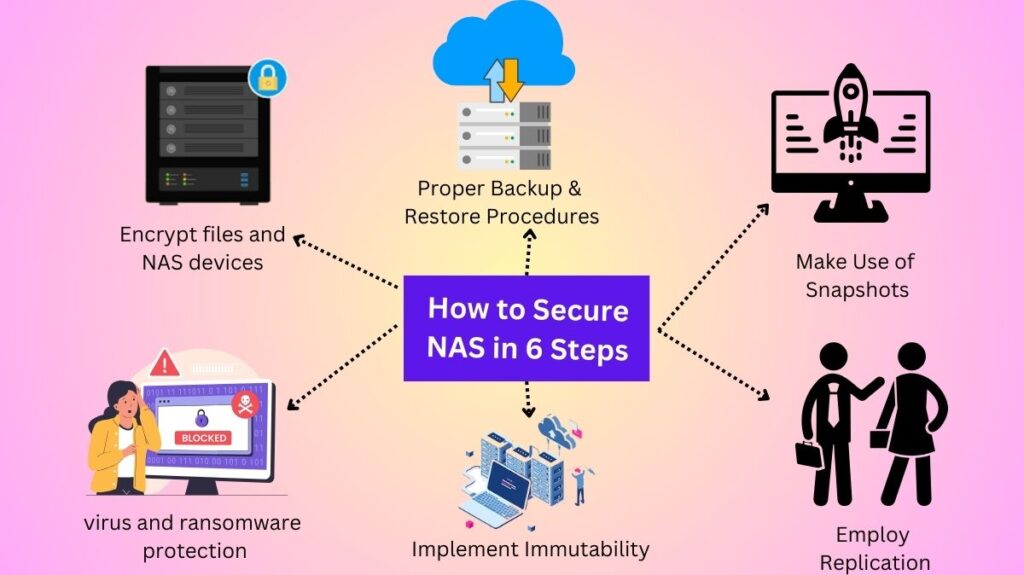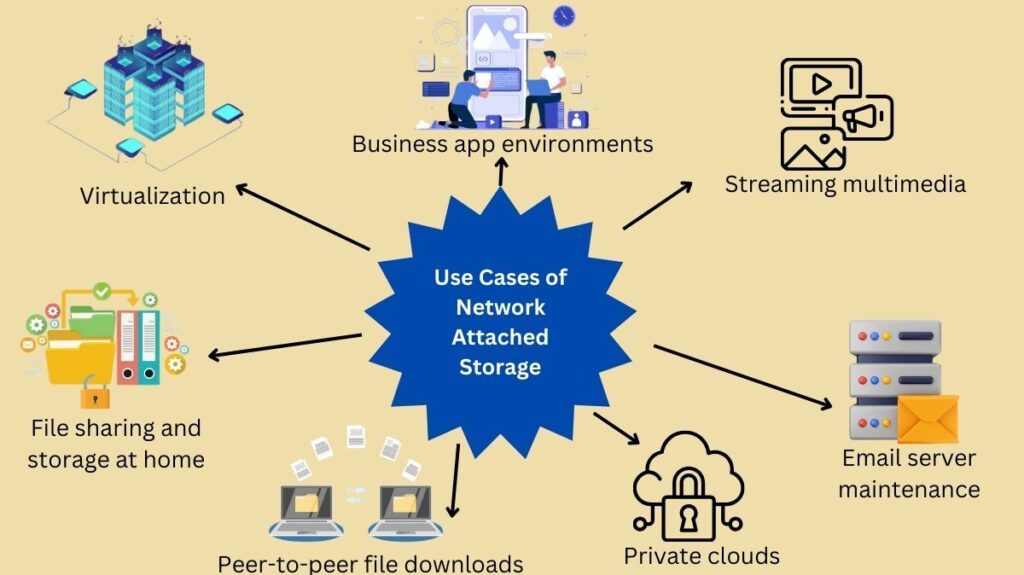Network attached storage security
Because network attached storage (NAS) is so popular in businesses, hackers profit from it. Regretfully, a lot of NAS systems lack adequate security. Some are vulnerable because they are poorly patched, misconfigured, or unencrypted, while others are unsecured because they employ antiquated protocols or have excessively lenient authorised access settings.
Because NAS is linked to the workplace network, the organisation and its data may be at risk since anyone with access to the NAS device may also have access to the network. Everything you need to know about network attached storage security is covered in detail in this article.
How Does Network Attached Storage (NAS) Security Work?
It’s critical to comprehend network attached storage in order to comprehend NAS security. By attaching it to the network, NAS saves data in a device that is accessible by numerous endpoints, in contrast to direct connected storage, which keeps files in a single physical endpoint.
Therefore, everything that is done to secure the organisation also applies to NAS security, which is a microcosm of the overall security picture. It is necessary to implement firewalls, update patches, properly specify access rights, and encrypt systems.
NAS security is not something that is handled independently or by a different security team. Those in charge of organisation security in general must to keep up with the latest developments in NAS security and incorporate NAS files into their security measures.
6 steps to Network attached storage security
Numerous security vectors, including as malware, ransomware, phishing, human mistake, irate workers, and brute force attacks, must be prevented from accessing NAS. There are several fundamentals to take into account for NAS security, but there is a whole area dedicated to specific security measures against these dangers.

Encrypt files and NAS devices
For NAS, encryption is the most basic security measure. Strong protection is offered by AES 256-bit methods, which must be accessed with a decryption key. Without an encryption key, the data cannot be accessed, even in the event that the system is compromised. Both in transit and at rest that is, while it is being transferred across the network and while it is being stored in NAS devices NAS data should be encrypted.
Use virus and ransomware protection
Sometimes, virus defence is seen negatively. Even though it’s an outdated, reactive technology that has been shown to be flawed, it’s still a useful first line of defence. Imagine it like locking and closing your front door while leaving a light on to give the impression that someone is home. A significant percentage of current malware is still detected by virus protection, and antivirus (AV) companies frequently update their viral signatures.
Another crucial component of NAS security is ransomware protection. Software built into more recent NAS systems can identify new ransomware threats, notify IT, and take action to stop intrusions.
Use Proper Backup and Restore Procedures
Similar to antivirus software, backup isn’t given the consideration it merits. All NAS devices and files should be routinely backed up on a schedule that reflects their worth to the company because it’s a tried-and-true approach of protecting the corporation.
However, even companies with sound backup procedures unintentionally overlook files. For instance, the backup administrator might not be aware of a few new NAS devices added by IT and may therefore omit them from the backup roster. Verify that all NAS data is backed up, and test recovery procedures often to find any gaps that need to be filled.
Implement Immutability
It is impossible to edit, modify, overwrite, or remove immutable files. Making sensitive data stored on NAS devices unchangeable is a clever strategy. This method of locking down data can also stop hackers from encrypting them and using them in a ransomware assault.
Make Use of Snapshots
A NAS system can be restored to a previous state, such as before an error, attack, or system failure, with snapshots. Combined with immutability, snapshots can offer a genuine defence against intrusion. The snapshot enables IT to restore the NAS to a previous version even in the event of a breach. They also recover much more quickly than backups, but they should be viewed as an addition to backups rather than a substitute.
Employ Replication
In essence, replication is a solid method to guarantee that NAS data is available. Because synchronous replication is more costly and done in real-time, it need to be saved for mission-critical NAS data. Since asynchronous replication is far less expensive to operate and is not done in real time, it may be utilised for everything else.
Use Cases of Network Attached Storage

Virtualization
Users of Windows Server-based file servers and Windows Powered Network Attached Storage (WPNAS) now have access to a new tool: NAS Virtualization. Both VMware and Hyper-V support respective NAS datastores, and utilisation is increasing. This is a common choice for new or modest virtualised installations when a business does not yet have a storage area network (SAN). The usefulness, performance, and capacity of contemporary NAS systems have increased. NAS solutions are now being employed in applications Its never would have thought possible in the recent past because of their enhanced capabilities.
File sharing and storage at home
As technology has advanced, a lot of people now have NAS systems set up in their homes so they can share and store files with their loved ones. NAS, which is incredibly elastic, scalable, and long-lasting, can be used for developing enterprise systems that share files and data.
In mid-sized, SMB, and corporate distant offices, this is the primary use case for network attached storage. When utilising a hard disc, the main function of a NAS device is usually file storage. The most popular NAS devices for home offices, small enterprises, and enterprise workgroups typically include two to five hard drives.
Downloading files from peer-to-peer
Since NAS can transfer files silently in the background, it eliminates the need to use a PC or laptop for peer-to-peer file transfers via torrents. The first configuration of the NAS equipment for torrent storing will be done by a field service specialist.
After that, all that is left to do is configure the file transfer client, establish the connection, allow the NAS to manage uploads and downloads, and even have the file stored in a central area after it is complete. The NAS can be controlled via its browser-based user interface or a remote client on an Android tablet or phone.
Environments for business apps
There are open-source alternatives accessible, and many of them will service an office from NAS, even if a corporation lacks the funds to run pricey server-based software. This is true for many business domains, such as accounting, customer relationship management (CRM), human resource management (HRM), and enterprise resource planning (ERP).
For example, OrangeHRM manages HR requirements, whereas SugarCRM or Vtiger, which are accessible on multiple NAS systems from various manufacturers, may be used if a CRM is required. Programs that target certain industries or markets, such as Moodle in the educational sector, are also available to users.
Private clouds
Since storage is NAS’s speciality and making the NAS available via the internet is not simple, it is evident that NAS manufacturers are aiming for cloud storage services like Dropbox, OneDrive, and Google Drive. A key feature of NAS-based commercial products for a long time has been the ability to upload and download files via a browser-based user interface.
Furthermore, one maintains data ownership and NAS storage is substantially less expensive than standard private cloud storage. However, if a user owns a company that maintains the data of others, this entails additional security obligations.
Multimedia streaming
A user should transfer their vast collection of old videos to the NAS if they know what to do with them. Convert the DVDs into H.264 video files, then upload these as well. Installing a third-party program like Twonky or Plex or setting the NAS’s video server application are other ways to set up a Netflix account.
After it’s up and running, you may stream videos to smart TVs, tablets, smartphones, and other connected devices. One can choose the file and streaming quality, and there won’t be any surprise price rises or advertisements.
Email server maintenance
It is definitely lot easier to set up and manage webmail or hosted email. Nonetheless, many NAS solutions provide with the tools necessary for an IT administrator to try administering their email system for either personal or business use. Some allow users to check incoming messages from any browser, such as webmail. One can access email servers with particular providers by using a POP3 or IMAP client.
Used Network Attached Storage
Network attached storage is meant to facilitate better user collaboration and data sharing. Distributed teams who operate in different time zones or require remote access can benefit from it. NAS connected to a wireless router lets distributed workers access files from any networked desktop or mobile device. A NAS system is frequently used by organisations as a storage filer or as the basis for a private or personal cloud.
Large businesses are the target market for some NAS devices. Others are for tiny enterprises or home offices. Although single-bay systems are available for noncritical data, devices typically have two or more drive bays. Enterprise NAS equipment typically has at least four drive bays and is built with more advanced data capabilities to help with storage management.
Businesses had to set up and maintain hundreds or even thousands of file servers before NAS. Scale-up NAS refers to NAS machines that are equipped with more or larger discs in order to increase storage capacity. Additionally, appliances are grouped together for scale-out storage.
Additionally, the majority of NAS vendors collaborate with cloud storage providers to offer redundant backup options to their clients.
Network attached storage has the benefit of collaboration, but it can also have drawbacks. Data is served by hard disc drives (HDDs) in network attached storage. When too many users overload the system with requests at once, I/O conflict may result. Faster SSDs or flash storage, either in all-flash designs or as a tier with HDDs, are used in more recent systems.
Difference Between NAS and SAN
| Feature | NAS (Network Attached Storage) | SAN (Storage Area Network) |
| Definition | A file-level storage system providing shared access over a network. | A block-level storage system designed for high-speed data transfer. |
| Storage Type | File-based storage (e.g., NFS, SMB). | Block-based storage (e.g., iSCSI, Fibre Channel). |
| Network | Uses standard Ethernet networks. | Uses Fibre Channel or Ethernet (with iSCSI). |
| Primary Use Case | Suitable for small to medium-sized businesses and file sharing. | Used in enterprise environments for high-performance applications. |
| Performance | Moderate; affected by the Ethernet network performance. | High; optimized for speed and low latency. |
| Complexity | Simple to install and manage. | Complex to set up and maintain. |
| Scalability | Moderate scalability. | Highly scalable to support large enterprise systems. |
| Access Protocols | NFS, SMB/CIFS. | iSCSI, Fibre Channel, FCoE. |
| Cost | Relatively cost-effective. | Higher cost due to specialized hardware and setup. |
| File System | NAS devices handle their own file systems. | File systems are managed by the server or host. |
| Data Sharing | Ideal for file sharing among multiple users. | Focused on providing dedicated storage to servers. |
| Fault Tolerance | Built-in features like RAID, snapshots, and replication. | High-level redundancy with advanced features like multi-pathing. |
| Use in Virtualization | Limited, mostly in small-scale virtual environments. | Preferred for virtualized environments requiring high performance. |
